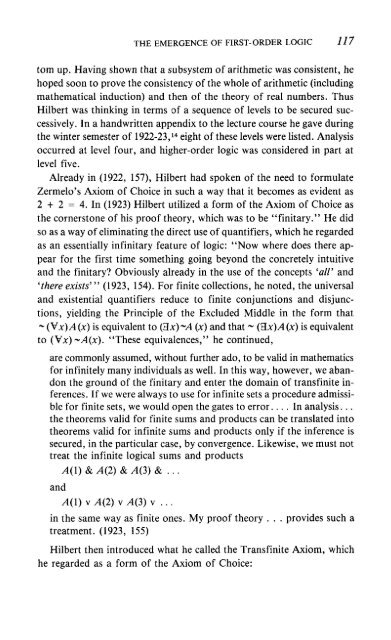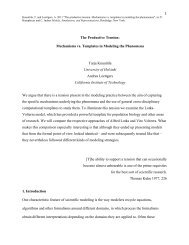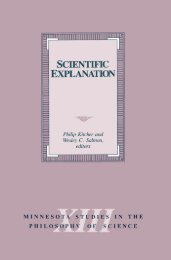The Emergence of First-Order Logic
The Emergence of First-Order Logic
The Emergence of First-Order Logic
You also want an ePaper? Increase the reach of your titles
YUMPU automatically turns print PDFs into web optimized ePapers that Google loves.
THE EMERGENCE OF FIRST-ORDER LOGIC 777<br />
torn up. Having shown that a subsystem <strong>of</strong> arithmetic was consistent, he<br />
hoped soon to prove the consistency <strong>of</strong> the whole <strong>of</strong> arithmetic (including<br />
mathematical induction) and then <strong>of</strong> the theory <strong>of</strong> real numbers. Thus<br />
Hilbert was thinking in terms <strong>of</strong> a sequence <strong>of</strong> levels to be secured successively.<br />
In a handwritten appendix to the lecture course he gave during<br />
the winter semester <strong>of</strong> 1922-23, 14 eight <strong>of</strong> these levels were listed. Analysis<br />
occurred at level four, and higher-order logic was considered in part at<br />
level five.<br />
Already in (1922, 157), Hilbert had spoken <strong>of</strong> the need to formulate<br />
Zermelo's Axiom <strong>of</strong> Choice in such a way that it becomes as evident as<br />
2 + 2 = 4. In (1923) Hilbert utilized a form <strong>of</strong> the Axiom <strong>of</strong> Choice as<br />
the cornerstone <strong>of</strong> his pro<strong>of</strong> theory, which was to be "finitary." He did<br />
so as a way <strong>of</strong> eliminating the direct use <strong>of</strong> quantifiers, which he regarded<br />
as an essentially infinitary feature <strong>of</strong> logic: "Now where does there appear<br />
for the first time something going beyond the concretely intuitive<br />
and the finitary? Obviously already in the use <strong>of</strong> the concepts 'all' and<br />
''thereexists'" (1923, 154). For finite collections, he noted, the universal<br />
and existential quantifiers reduce to finite conjunctions and disjunctions,<br />
yielding the Principle <strong>of</strong> the Excluded Middle in the form that<br />
~ (Vx)A (x) is equivalent to (Bx)~A (x) and that ~ (3.x) A(x) is equivalent<br />
to (Vx)~A(x). "<strong>The</strong>se equivalences," he continued,<br />
are commonly assumed, without further ado, to be valid in mathematics<br />
for infinitely many individuals as well. In this way, however, we abandon<br />
the ground <strong>of</strong> the finitary and enter the domain <strong>of</strong> transfinite inferences.<br />
If we were always to use for infinite sets a procedure admissible<br />
for finite sets, we would open the gates to error.... In analysis...<br />
the theorems valid for finite sums and products can be translated into<br />
theorems valid for infinite sums and products only if the inference is<br />
secured, in the particular case, by convergence. Likewise, we must not<br />
treat the infinite logical sums and products<br />
,4(1) & A(2) & ,4(3) & ...<br />
and<br />
A(\) v A(2) v A(3) v ...<br />
in the same way as finite ones. My pro<strong>of</strong> theory . . . provides such a<br />
treatment. (1923, 155)<br />
Hilbert then introduced what he called the Transfinite Axiom, which<br />
he regarded as a form <strong>of</strong> the Axiom <strong>of</strong> Choice:




